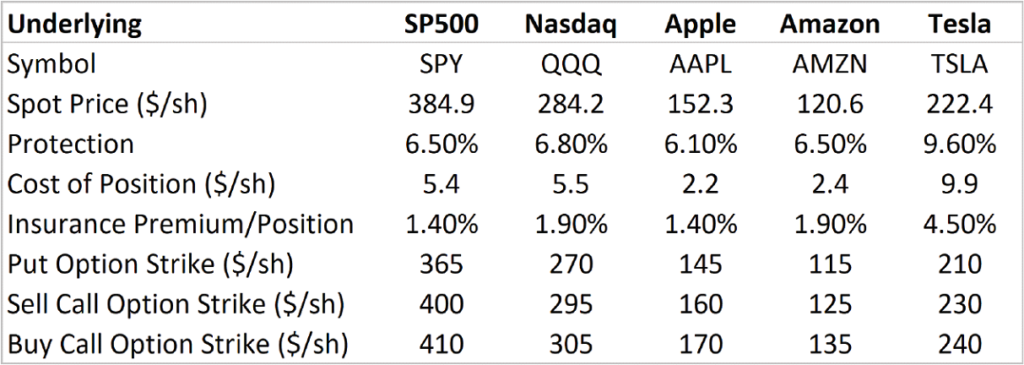Buying Insurance in the Equity Market
Investing in equities is inherently risky, but the capital market offers alternatives to mitigate this downside. Diversification is well understood by most investors, but it’s a limited tool. Mixing bonds and stock, or maintaining a diverse portfolio of individual securities, allows investors to reduce the risk of a single security (or a particular industry) hitting negative catalysts (a consumer goods company with a failed product launch, or energy stocks with a crash in oil prices).
However, diversification is poor protection against market-wide risks that affect the entire spectrum of assets (i.e., “not diversifiable risks”) For example, in 2022 rising inflation and interest rates have affected a vast majority of equities and bonds (SP500 is down -19.4% and 20yr treasuries -34% year-to-date). This has led portfolios, even widely diversified portfolios, to accumulate deep losses.
On August 23, we looked at one of the simplest strategies to protect investors against “non diversifiable risks.” It’s a straightforward idea: buy a put option, partially defraying the cost by selling a call option spread.
In this example, we used the SPY ETF, which tracks the SP500, for illustration purposes, but the strategy can be deployed using any stock or ETF with an associated liquid options market.
Keeping the Insurance Live
Regardless of the underlying security, it is important to maintain (i) an “insurance premium” (i.e., the market value of the position) at a reasonably low percentage of the protected position; and (ii) setting the protection threshold within a reasonable distance of the protected position’s price.
In the previous example, the strategy protected against a loss above 8.7% and the “insurance premium” was 1.4% of the protected capital. This percentage will increase for more volatile names and remain contained for more stable securities.
The following examples provide similar protection for a range of underlying securities, including index-tracking ETFs and some individual stocks. They are all based on options expiring Dec 16.
What could go wrong with this type of strategy?
An insurance strategy does not intend to be an isolated profit driver, but rather a protection against a negative market move. In this case, the strategy seeks to protect an underlying position ($36.5k of SPY) against a sell-off more than ~5%. Therefore, it should be measured in tandem with the underlying position rather than on a standalone basis. Moreover, the best overall outcome for the investor is to lose the value of the insurance “premium,” as for this implies the underlying asset price increased (same as buying home fire insurance – the best outcome is never to use it).
© 2022 Securities are offered by Lime Trading Corp., member FINRA & SIPC, NFA, Lime Advisory Corp is an investment adviser registered with the SEC. and Lime FinTech is a technology business. Collectively known as “Lime Financial” or “Lime” provide various trading, investment advisory services, and technology solutions including web and mobile trading applications, to retail and institutional investors. All investing incurs risk, including but not limited to loss of principal. Further information may be found on our Disclosures Page.
Please read the Options Disclosure Document titled “Characteristics and Risks of Standardized Options” before trading options.
Options trading entails significant risk and is not appropriate for all investors. Certain options strategies carry additional risk and investors may lose 100% of funds invested in a short period of time. Investors should consult with a tax advisor as to how taxes may affect the outcome of any options strategy. Options trading privileges are subject to Lime Trading Corp. review and approval. Transaction costs may be significant in multi-leg option strategies, including spreads and straddles, as they involve multiple commission charges.
This material has been prepared for informational purposes only and is NOT intended to provide nor should it be relied on for tax, legal, or accounting advice. Please consult your own tax, legal, and accounting advisors before engaging in any securities transactions as each individual investment(s) may result in diverse/adverse tax implications that will affect the outcome of any investment strategy. No information presented herein should be considered an offer to buy or sell a particular type of security. This is not an offer or solicitation in any jurisdiction where we are not advertised to do business. Other fees, such as regulatory, service, or other fees, may apply. Please visit our Pricing Page for further information. Investments involve risk, past performance does not represent future results. Diversification may help spread risk but does not protect in a down market. You may lose all of your investment. Investors should evaluate their financial situation, investment objectives, and goals before investing. Substantial risks are involved with electronic trading. Day trading involves significant risk and is not suitable for all investors. Please see our Day Trading Risk Disclosure Statement for more detailed information. Trading on margin is not appropriate for every investor. Please see our Margin Disclosure Statement for information on risks. System response may vary due to multiple factors including but not limited to trading volumes, market conditions, system performance, and other factors. Access to electronic services may be limited or unavailable during periods of peak demand, market volatility, systems upgrades, maintenance, or for other reasons.
Exchange Traded Funds (ETFs) are subject to market risk, including the loss of principal. The value of any ETF and thus the portfolio that holds an ETF will fluctuate with the value of the underlying securities in the ETF reference basket. ETFs trade with the same brokerage commissions associated with buying and selling equities unless trading occurs in a fee-based account. ETFs often trade for less than their net asset value. Refer to Disclosure Statements | Lime Financial.





